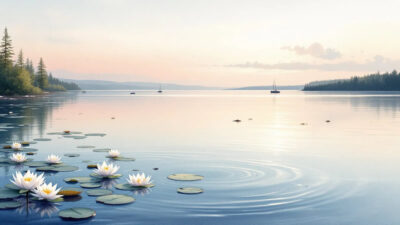Top Lake Ontario Fishing Tips
Catch More Bass, Salmon, and Trout

Want to make the most of your Lake Ontario fishing trip? This article covers the top fishing spots, the best times to go, and essential techniques for catching salmon and trout. Whether you’re new or experienced, fishing the Canadian or New York side, you’ll find useful tips to enhance your experience.
Key Takeaways
- Lake Ontario offers diverse fishing opportunities with over 122 species, including salmon and trout, catering to all skill levels.
- Successful fishing relies on understanding the best times for targeting specific species, with peak salmon fishing occurring from late July to early September.
- Proper gear and techniques, such as trolling and fly fishing, along with awareness of fishing regulations, are essential for a productive and safe fishing trip.
Discover Onterio Lake New York
Why Fish Lake Ontario?

Whether you are an experienced angler or a beginner, Lake Ontario caters to all skill levels. The lake’s vast expanse and rich fish populations ensure that everyone can enjoy fantastic brown trout fishing, fly fishing, or bass fishing. The camaraderie among fellow anglers and the opportunity to catch big fish make fishing in Lake Ontario a truly rewarding experience.
Best Times to Fish Lake Ontario
Proper timing can make or break a fishing trip to Lake Ontario. The salmon fishing season runs from April to September. The peak period happens from late July to early September. Coho salmon, known for their aggressive behavior, can be caught during their spawning runs in April and early May, and again in late summer for fall spawning.
For those targeting brown trout, the best time is from April to June, although successful fishing can continue from March through August. These fish tend to stay near shorelines in shallow waters during early spring, particularly at depths of 10-20 feet. Timing and location are key, with optimal fishing conditions often found during calm, sunny days with high pressure.
Lake trout are most active when water temperatures are cooler, making early spring and late summer ideal times to fish for them. These fish are often located near shore and are accessible to anglers with smaller boats during these periods. Whether you prefer fly fishing or trolling, understanding the best times to fish Lake Ontario will significantly enhance your chances of success.
Top Fishing Locations on Lake Ontario

Utilizing proper techniques and understanding fish patterns can greatly enhance success rates in these prime fishing locations on Lake Ontario. The following subsections provide detailed insights into each of these top fishing spots, ensuring you are well-prepared for a productive fishing trip.
St Lawrence River
The St. Lawrence River is a vital waterway that serves as a natural outflow for Lake Ontario, linking it to the Atlantic Ocean. This majestic river begins at the northeastern end of Lake Ontario and flows northeastward through Canada, forming part of the boundary between the United States and Canada. It stretches for over 700 miles, providing a crucial shipping route and supporting a rich ecosystem.
Niagara River
The Niagara River is renowned for its robust populations of salmon and trout, making it a favored destination for anglers. The river offers distinct fishing experiences above and below Niagara Falls, with different fish species thriving in each section.
The Upper Niagara River is particularly known for Smallmouth Bass, especially in less crowded areas. However, its strong currents make it a challenging yet rewarding fishing spot best suited for experienced anglers.
Salmon River
The Salmon River is a hotspot for anglers seeking diverse salmon species, including king salmon. Famous for its annual spawning runs, the river draws numerous anglers looking to catch trophy-sized salmon and trout.
The river also offers numerous public access areas, making it easier for anglers to participate in the thrilling fishing experience during the spawning season.
Oswego River
The Oswego River is home to Oswego Harbor. It has a plentiful population of salmon. Recognized as a significant fishing location due to its rich ecosystem, the Oswego River provides excellent opportunities for anglers to catch various salmon species.
Essential Gear for Lake Ontario Fishing

Common lures for lake trout include Husky Devil, T-60 Flatfish, and various smaller spoons to entice ‘action’ trout. Popular lures for trolling include spoons, plugs, and attractors with cut-bait. Other options are flies and peanuts. Bright colors such as green, white, chrome, chartreuse, orange, red, and glowing baits are particularly effective for salmonids.
Methods like downriggers, divers, wire lines, copper lines, and lead core lines are employed to get lures to the right depth while trolling. A line capacity of 250 to 400 yards of 15-pound test monofilament line is recommended for trolling. Additionally, planer boards are used to get the lure away from the boat, increasing the chances of a successful catch.
Techniques for Successful Fishing
Mastering effective fishing techniques is crucial for successfully catching salmon and trout in Lake Ontario. Techniques like dry fly and nymphing can significantly enhance your fishing success. The dry fly technique involves presenting floating fly patterns on the water’s surface, targeting fish feeding on insects. Nymphing, which imitates underwater insect stages, is one of the most productive methods for catching trout.
The following subsections delve into specific fishing techniques, including trolling, fly fishing, and shore fishing, each tailored to maximize your chances of catching trophy fish in Lake Ontario.
 Trolling
Trolling
Trolling is the favored technique for fishing on Lake Ontario. It is the preferred angling method among anglers in the area. Bright-colored baits are particularly effective for catching Coho salmon. Trolling in an S-curve can provoke more strikes.
Essential trolling tools include downriggers to fish at specific depths, planer boards to cover a wider area, and proper lines, such as lead core, to reach the desired depth.
Fly Fishing
Fly fishing in tributary mouths attracts baitfish, making it highly effective as larger fish congregate there. The primary species targeted are rainbow trout and Atlantic salmon. Imitating local baitfish patterns, particularly during feeding times, can yield excellent results.
Paying attention to water temperature and flow helps identify the best times for fishing in these areas.
Shore Fishing
Shore fishing offers access to many productive areas where anglers can catch bass and northern pike. Effective shore fishing often involves using lures that mimic the local prey in the area.
This method provides an excellent opportunity for anglers without a boat to enjoy Lake Ontario’s rich fishing potential.
Safety Tips for Anglers
Safety should always be a top priority when fishing on Lake Ontario. A depth finder is an essential piece of equipment that ensures you fish in the right locations. An emergency boat kit, including a watertight flashlight, 50-foot rope, bailing bucket, and whistle, is mandatory for safety. Wearing a life jacket at all times is crucial, as is carrying a first aid kit and ensuring all safety gear is in good condition.
For safety on a fishing boat, it is essential to wear non-skid, rubber-soled shoes. Sunscreen that protects against both UVA and UVB rays helps prevent sunburn during fishing trips. A small first aid kit with basic supplies like bandages and antiseptic cream is advisable for handling minor injuries while fishing.
It’s also recommended that you carry a waterproof bag to protect electronic items and important documents. Always check weather and water conditions before going out, and avoid fishing in storms or rough waters.
Understanding Water Temperature
Understanding water temperature is crucial for a successful fishing trip. During summer, Lake Ontario has three main temperature zones: the epilimnion (62 – 80°F), a thermocline (narrow band), and the hypolimnion (39 – 52°F). Thermal stratification creates distinct layers that affect fish behavior and their preferred locations. Knowing where these temperature layers are can help anglers locate and catch fish more effectively.
In winter, lake trout and other cold-water fish remain active in deeper waters with stable temperatures around 39°F. Understanding the seasonal temperature changes in Lake Ontario helps anglers know when to fish for specific species, enhancing their chances of a successful catch.
Lake Ontario Charter Captains
Lake Ontario Fishing Regulations
Knowing the regulations before Lake Ontario fishing is essential for a successful and legal fishing trip. The fishing season for Chinook and Coho salmon runs from early September to early November, with peak salmon fishing typically occurring during the first two weeks of October. Familiarizing yourself with fishing regulations helps in adhering to catch limits and gear restrictions, ensuring sustainable fishing practices.
Anglers are required to follow size limits for certain species, which helps protect fish populations and maintain a healthy ecosystem. The following subsections provide detailed information on fishing regulations for both American and Canadian waters of Lake Ontario.
American Waters
Fishing regulations in American waters of Lake Ontario include specific catch limits and restrictions. For instance, there is a daily limit of three trout and salmon combined, but only one Atlantic salmon is allowed. Lake trout fishing is permitted year-round with a minimum length restriction of 12 inches and a daily limit of two.
Specific seasonal regulations apply to tributaries, including gear restrictions and fishing hours. Additionally, foul-hooked fish must be immediately released without unnecessary injury, and the use of gaff hooks is prohibited.
Canadian Waters
In Canadian waters, fishing regulations for Lake Ontario also ensure sustainable practices. Ontario mandates an aggregate limit of five trout and salmon combined, and fish must be released if the daily catch limit is exceeded.
These regulations help maintain the fish population and ensure that anglers can enjoy fishing in Lake Ontario for years to come.
Lake Ontario Fish Species Guide
Lake Ontario is renowned for its diverse fish species, making it a prime destination for anglers. The lake is home to Chinook salmon, Coho salmon, rainbow trout, brown trout, lake trout, smallmouth bass, and more. Chinook salmon, known for their size and fight, can weigh between 8 to 30 pounds, making them a sought-after catch. Coho salmon and Atlantic salmon are also prevalent in Lake Ontario, offering anglers a variety of salmon species to target.
Rainbow trout thrive in Lake Ontario, especially at tributary mouths during migration. Brown trout are typically found along shorelines and tributary mouths in early spring. Common forage fish like alewife and rainbow smelt support the trout and salmon populations, providing ample feeding opportunities.
Fly fishing is particularly effective for targeting trout in Ontario, often outperforming traditional fishing techniques.
Bass Fishing
Lake Ontario is a haven for bass fishing enthusiasts, offering exceptional opportunities to catch both smallmouth and largemouth bass. The lake’s diverse habitats provide ideal conditions for these popular sport fish. Smallmouth bass are typically found in the deeper, rocky areas of the lake, where their aggressive nature and powerful fights make them a thrilling catch for anglers.
In contrast, largemouth bass prefer the warmer, shallower waters, often inhabiting weedy or sheltered areas near the shore. These fish are known for their explosive strikes and acrobatic displays, providing an exciting challenge for those targeting them. Whether you’re casting from a boat or fishing from the shore, Lake Ontario’s bass fishing offers an exhilarating experience, drawing both local and visiting anglers eager to test their skills against these formidable fish.
Chinook Salmon
The ideal season for fishing Chinook salmon in Lake Ontario is from spring to late summer, with peak times during July and August. These fish move farther offshore in search of cooler water during summer.
Effective baits for catching Chinook salmon in deeper water include flasher and flies, flasher and cut-bait, and spoons. The optimal water temperature for Chinook salmon is 53°F.
Coho Salmon
Coho salmon are known for their aggressive fighting behavior, making them a popular target for anglers. The state record weight for Coho salmon in Lake Ontario is 33 lb 7 oz.
These fish are typically targeted during their migration and spawning runs, providing exciting fishing opportunities.
Atlantic Salmon
Atlantic salmon populations in Lake Ontario have faced challenges such as fishing pressure, agriculture, and pollution. Despite being less numerous than other salmonids, they are a prized catch for anglers. A distinctive feature of Atlantic salmon is their lack of spots on the tail. Their primary prey in Lake Ontario is the alewife.
In Canadian waters, Atlantic salmon must be a minimum of 25 inches to be kept.
Lake Trout
Lake trout are the largest native salmon species in Lake Ontario, with some individuals exceeding 40 pounds. They prefer cold water and are most active in cooler temperatures. During spring and summer, lake trout typically feed in a 50-foot depth range, making them a popular target for anglers seeking lake Ontario trout.
To effectively catch lake trout, use lures such as spoons and spinners. Other effective options include peanuts, dodgers/flashers, and fly rigs.
Brown Trout
Brown trout are typically found in warmer waters, especially near tributaries. These areas are prime spots for anglers during the spring. Early spring is when brown trout begin to be the best time to target brown trout, as they are more active in warmer water.
Due to their habitat preferences, brown trout can be easily accessed by anglers fishing near shorelines.
Rainbow Trout
Rainbow trout, including steelhead, are a key species in Lake Ontario. The Niagara River is particularly notable for its runs of salmon and steelhead during seasonal migrations. Approximately 75,000 domestic rainbow trout are stocked annually in Lake Ontario to maintain healthy fish populations.
These fish show improved activity during sunny days, with the best results occurring at first light and the last hour of daylight. Rainbow trout are typically found higher in the water column, generally above the thermocline.
Lake Ontario Reviews
CLICK TO WRITE A REVIEW
Lake Ontario Map
Table Rock Lake, Mo
Planning Your Lake Ontario Fishing Trip

To fish in Ontario waters, a fishing license is mandatory. Non-residents need both an Outdoors Card and a fishing license to fish legally in Lake Ontario. Anglers must follow specific catch and possession limits, which vary by Fisheries Management Zones in Ontario. Understanding these regulations is crucial for a successful and legal fishing trip.
Additionally, consider the best times to fish for specific species and the essential gear needed for different fishing techniques. Whether you are planning a solo trip or going with fellow anglers, having a well-thought-out plan will enhance your fishing experience on Lake Ontario.
Summary
Lake Ontario fishing offers an exceptional experience with its diverse fish species and prime fishing locations. By understanding the best times to fish, using the right gear, and mastering effective techniques, you can maximize your chances of catching trophy fish. Familiarizing yourself with fishing regulations and planning your trip carefully will ensure a successful and enjoyable adventure. So gather your gear, plan your trip, and get ready for an unforgettable fishing experience on Lake Ontario.
What are you waiting for?
How to Book the Best Lake Okeechobee Fishing Charters
Choosing Lake Okeechobee fishing charters is one of the fastest ways for anglers like us to boost our bass fishing success, yet figuring out which...
11 Best Family Friendly Fishing Charters for Your Trip
Finding the right family friendly fishing charters can make all the difference for anglers who want to share real learning and adventure with their...
11 Best Boat Ramps Near the Harris Chain for Easy Launches
Finding the best boat ramps near the Harris Chain can be the difference between a rushed morning and a dialed-in launch. We’ve selected and reviewed...
Frequently Asked Questions
When is the best time to fish for salmon in Lake Ontario?
The optimal time to fish for salmon in Lake Ontario is from April to September, with the peak season occurring from late July to early September. Planning your fishing trips during this timeframe will increase your chances of a successful catch.
What are the essential gear items for fishing on Lake Ontario?
The essential gear for fishing on Lake Ontario includes rods, reels, braided lines, a variety of lures, and trolling equipment such as downriggers and planer boards. Having the right equipment is crucial for a successful fishing experience.
What are the top fishing locations on Lake Ontario?
The top fishing locations on Lake Ontario are the Niagara River, Salmon River, and Oswego River, which provide excellent opportunities for salmon and trout fishing. These areas are renowned for their diverse fisheries and attract avid anglers seeking a successful catch.
What are the fishing regulations in the American waters of Lake Ontario?
Fishing regulations in the American waters of Lake Ontario stipulate a daily limit of three trout and salmon combined, along with specific size and seasonal restrictions. It is essential to adhere to these rules for sustainable fishing practices.
How does water temperature affect fishing in Lake Ontario?
Water temperature significantly impacts fishing in Lake Ontario by influencing fish behavior and their preferred habitats, as thermal stratification leads to distinct layers that dictate fish distribution. Understanding these temperature dynamics can enhance your fishing experience.
Nearby Lake Ontario Fishing Destinations
Suppose you enjoy fishing at Lake Ontario. We also have great deals available on the following lakes that match your search criteria.












 Trolling
Trolling










